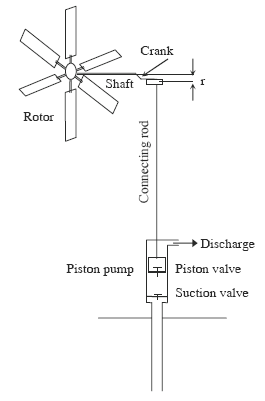Related Resources: calculators
Wind Mill Powered Piston Pumps Design Equation and Calculator
Fluid Flow Hydraulic and Pneumatic Engineering and Design Menu
Applications and Design
Wind Mill Powered Piston Pumps Design Equation and Calculator
Positive displacement piston pumps are used in most of the commercial wind pumps. Constructional features of such a system are shown in Fig. 1. The system consists of a high solidity multi-vane wind rotor, drive shaft, crank, connecting rod and a reciprocating pump. Rotary motion of the windmill rotor is translated to reciprocating motion of the connecting rod by the crank. The connecting rod operates the pump’s piston up and down through the cylinder during its strokes. Two check valves, both opening upwards, are fitted on the piston and the bottom of the pump. These valves allow the flow only in upward. direction.

Wind driven piston pump Figure 1
When the connecting rod drives the piston in the upward direction, the piston
valve is closed and thus the water column above the piston is lifted up, until it is
delivered out through the discharge line. At the same time, suction is created below the piston, which causes the suction valve to open and thus fresh water
from the well enter into the space below. During the downward stroke, the piston
valve is opened and the suction valve is closed. The water collected below the piston
thus enters into the space above, through the piston valve. These cycles are repeated
resulting in pulsating sinusoidal water discharge from the system.
The volume of water discharged during one delivery stroke is given by the product of inner area of the cylinder and the height through which the water column is displaced during a stroke. Thus, if d is the inner diameter of the pump cylinder and s is the stroke length (distance between the extreme lower and upper positions of the piston) then, theoretically the volume of water pumped per discharge stroke is given by
Eq. 1
Vs = π · d2 · s / 4
Eq. 2
s = 2 · r
where r is the crank length. As the pump delivers one discharge per revolution of the wind rotor, the discharge is given by
Eq. 3
Q = ηv · Vs · d2 · r · N / 2
where ηv is the volumetric efficiency of the pump and N is the rotational speed of the driving wind rotor. Usually, the volumetric efficiency of piston pumps is quite impressive, typically higher than 90%. The power requirement of the pump (P ) for a discharge Q may be estimated by
Eq. 4
PH = ρw · g · Q · h / ηp
where ρw is the density of water, g is the gravitational constant, h is the total head against which the pump delivers water an ηp is the pump efficiency. Density of water, under standard ambient conditions, can be taken as 1000 kg/m3. The pumping head includes the suction head, delivery head as well as the frictional head. Similarly, the pump efficiency takes care of various efficiencies involved in converting the mechanical shaft power to hydraulic power.
Limitations of wind driven piston pumps
Mechanical coupling of a piston pump with wind rotor makes the system simple and cost effective. Many of such pumps are installed at different parts of the world. However, the field performances of these units are not encouraging.
The major reasons are:
- hysteresis behavior of the system due to its high starting torque demand
- mismatch between the characteristics of the rotor and the pump
- dynamic loading of the pump’s lift rod.
Related:
- Pump Types | Pump Applications Pump Design Equations
- Hydraulic Ram for Pumping Water
- Vertical Turbine Pumps
- Wind Turbine Power and Torque Equation and Calculator
- Wind Turbine Power From Wind
- Wind Power Generation and Wind Power Turbine Design
- Aerodynamics of Wind Turbine
- Wind Energy Fundamentals
- Wind Energy, Renewable Energy and the Environment
- Hydraulic Turbine Power Formulae and Calculator
- Pressure Spike Water Hammer Review and Equations
- Pressure Spike Water Hammer Review and Equations
Source:
Sathyajith Mathew
Wind Energy Fundamentals, Resource Analysis and Economics